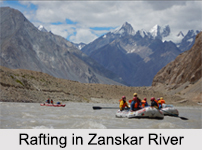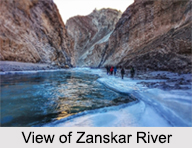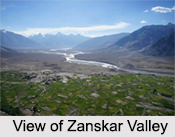 Zanskar, "The Land of White Copper" is exactly what it is referred to. Zanskar or Zangskar is a sub-district or tehsil of the Kargil district in the Indian state of Jammu and Kashmir. The administrative centre of this region is Padum. Zanskar, together with the neighbouring region of Ladakh, was briefly a part of the kingdom of Guge in Western Tibet.
Zanskar, "The Land of White Copper" is exactly what it is referred to. Zanskar or Zangskar is a sub-district or tehsil of the Kargil district in the Indian state of Jammu and Kashmir. The administrative centre of this region is Padum. Zanskar, together with the neighbouring region of Ladakh, was briefly a part of the kingdom of Guge in Western Tibet.
Etymology of Zanskar
Zanskar also appears as Zangskar mostly in academic studies in social sciences, which reflects the Ladakhi pronunciation. According to an etymological study Zangskar may refer to the natural occurrence of copper in this region, as Zangs is the Tibetan term of copper. But even if etymologically it would be more correct to use "Zangskar", the most frequently found spelling for this region is undoubtedly "Zanskar".
History of Zanskar
Until the 15th century, Zanskar existed as a more or less independent Buddhist Kingdom ruled by between two and four related royal families. Since the 15th century, Zanskar has been subordinate to Ladakh, sharing its fortunes and misfortunes. In 1822 a coalition of Kulu, Lahoul, and Kinnaur invaded Zanskar, plundering the country and destroying the Royal palace at Padum.
In the mid-20th century, border conflicts between India, Pakistan and China caused Ladakh and Zanskar to be closed to foreigners. During these wars, Ladakh lost two thirds of its original territory, losing Baltistan to Pakistan and the Aksai Chin to China. But Ladakh and Zanskar have never lost their cultural and religious heritage since the 8th century.
 Geography of Zanskar
Geography of Zanskar
Zanskar covers an area of some 7,000 square kilometers. It is located at an elevation of 3,500-7,000 meters. It covers the portion of the country which is lying along the two main branches of the Zanskar River. The first branch is the Doda, which has its source near the Penzi-la mountain pass. The second branch is formed by two main tributaries, which are known as Kargyag River, with its source near the Shingo La and Tsarap River, with its source near the Baralacha-La.
Climate of Zanskar
Zanskar is a high altitude semi-desert, which lies on the Northern flank of the Great Himalayan Range. This mountain range acts as a climatic barrier, which is protecting Ladakh and Zanskar from most of the monsoon. As a result of which, weather of Zanskar during summer season is pleasantly warm and dry.
Population in Zanskar
According to the April 2006 medical census record, Zanskar had a population of 13,849 people. Roughly 95% of the inhabitants practice Tibetan Buddhism and the rest are Sunni Muslims. The majority of Zanskaris are of mixed Tibetan and Indo-European origins, especially Changpa, Dard and Mon.
Occupation of People of Zanskar
The Zanskaris` main occupations are cattle-rearing and farming of land, which they almost always own. The people of this region have developed a system of intensive arable agriculture and complex irrigation to produce enough food in these conditions. The scarcity of cultivable land has also resulted in a tendency towards a stable and zero-growth population.
Religion in Zanskar
Besides some 300 Sunni Muslims living in Padum almost the whole population of Zanskar is Buddhist. There are mainly two main branches of Tibetan Buddhism- the Drugpa, including Sani Monastery, Dzongkhul, Stagrimo and Bardan Monaster; all are loosely affiliated to Stakna in the Indus valley.
Flora and Fauna in Zanskar
Most of the vegetation of Zanskar is found in the irrigated villages, on the upper slopes which receive most of the precipitation and where alpine and tundra species are found. Most impressive are the meadows, which are covered with thousands of edelweiss. At the foot of the Gumburanjon Mountain blue poppies can also be found. Crops including barley, lentils, and potatoes are grown by farmers at the lower elevations. Domesticated animals such as the yak, dzo, sheep, horse and dog are found in the region. The wildlife species of Zanskar are the marmot, bear, wolf, snow leopard, bharal, alpine ibex, wild sheep and goats, and the lammergeier.
 Language in Zanskar
Language in Zanskar
People of Zanskar speak in Zanskar Skad and they can also speak in mixed Hindi and Urdu, but read it. Monks who have studied outside of Zanskar may know Standard Tibetan. Educated people of Zanskar know English as it is a compulsory subject in Indian schools.
Tourism in Zanskar
Attractions of Zanskar are similar to other portions of Ladakh. Semi-arid landscape, monasteries, chortens, and scenic beauty are the main attractions of Zanskar; trekking and bike riding are also popular activities in this region.
Visiting Information to Zanskar
The best time to visit Zanskar is from June to September, which is the most favorable time among tourists to visit Ladakh region. Srinagar – Kargil – Padum is the best & fastest route to reach Zanskar. Another route to reach the place is via Manali-Leh Highway to reach Leh and then travel to Kargil-Padum route. Nearest airport to this location is Leh Airport and nearest railway station is Jammu Tawi, which is located at a distance of 730 km from Zanskar.



















